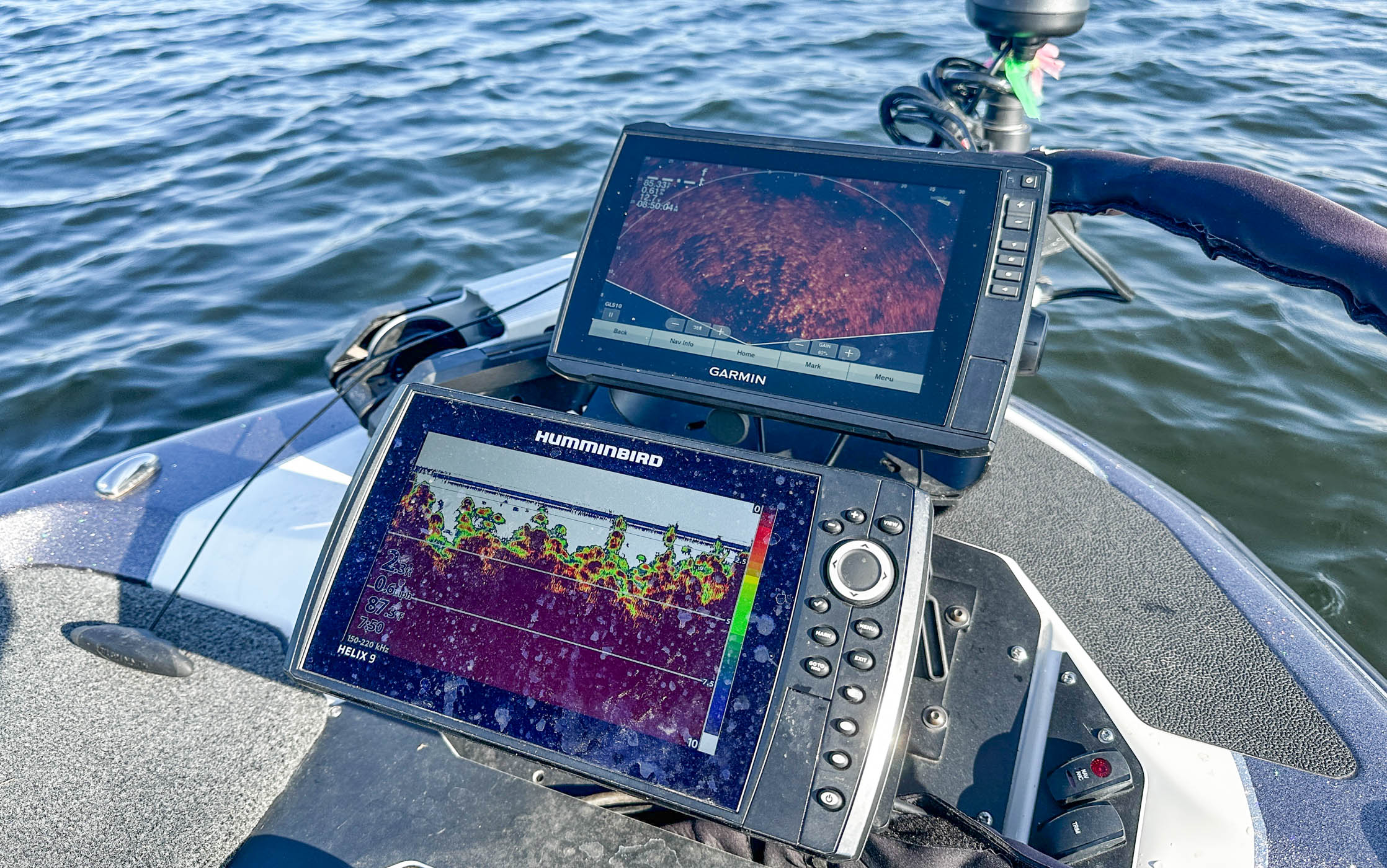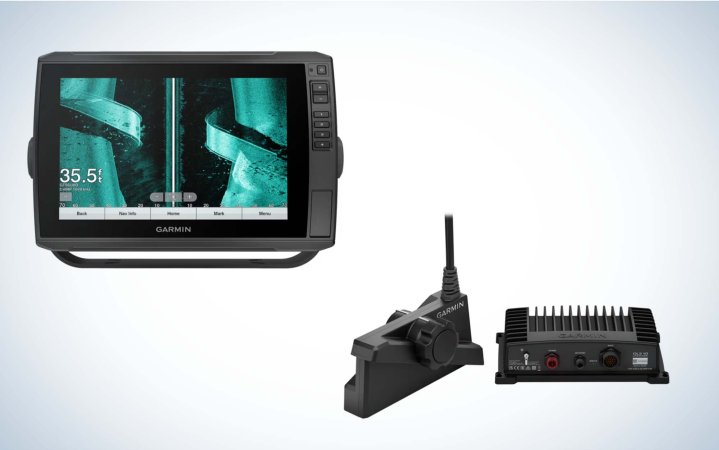We may earn revenue from the products available on this page and participate in affiliate programs. Learn More ›
Forward-facing sonar has changed the game in professional bass fishing. While some anglers and pundits have mixed or negative feelings about the relatively new technology there’s no question that it’s becoming more prevalent among non-pro anglers too.
FFS is not necessarily easy to learn or implement, but the best units from companies like Humminbird and Garmin are increasingly “plug and play.” Just by setting up your beam correctly, it’s possible to see fish, and even a small lure, 60 to 80 feet in front of the boat — or farther. Besides helping you locate fish, Humminbird’s MEGA Live and LiveScope can help anglers make adjustments to lure styles, colors and retrieves in real time. If you’re ready to make the leap into FFS, you’ll first have to decide on which unit to run. I compared two of the most popular units, MEGA Live and LiveScope, to help you decide.
MEGA Live Specs and Features
- Down Mode, Forward Mode, and Landscape Mode
- Compatible with TargetLock, which allows anglers to move the transducer independently of the trolling motor
- 2-Year Limited Warranty
- Sonar Coverage: 20 x 120 degrees
- Price: $1,500 (transducer only)
LiveScope Plus Specs and Features
- Forward Mode, Down Mode, and Perspective Mode
- Sonar Coverage: 20 x 135 degrees
- Built-in stabilization
- Price: $1,700 (transducer and sonar module only)
Testing MEGA Live and LiveScope


I owned Humminbird units on my past two boats, and switched to Garmin units on my current one. I’ve also previously owned Lowrance units, so I started this testing process with a pretty solid understanding of the top companies’ lineups. I supplemented that by getting into boats with top tournament anglers, practitioners and teaching guides including Texas pro Keith Combs, New York rookie phenom Kyle Patrick, and former competitor, now a provider of electronics lessons, Chad Morgenthaler. They all answered my questions directly and honestly. We fished water 2- to 60-feet deep, for largemouths, smallmouths, and spotted bass, in various seasons and water clarities. Without insights from the pros, I wouldn’t have learned half as much as I did, and I still have a long way to go to become anywhere near as proficient as them.
While I was introduced to both the Humminbird and Garmin units in the boats of the many bass pros, much of my testing came in my own boat. I wanted to see if someone without those professional advantages could learn these units and maximize their effectiveness. I did get some hints through YouTube and the occasional calls stemming from frustration, but I found that just getting up and running was not that hard. The difficulty is in maximizing their effectiveness.
Read Next: The Best Fish Finders
Megalive vs Livescope: Ease of Use
I found Garmin’s menus to be more intuitive and easier to scroll through and find what I needed. With Humminbird, sometimes it was less obvious. Once I understood the terminology and placement, they were close, but I’d still give the edge to Garmin.
However, in terms of hooking up all of the wiring, particularly at a dark boat ramp in the pre-dawn hours, I found Humminbird’s setup to be better. I could “feel” the placement of the wires and figure out where they should be. I don’t like leaving the units hooked up while trailering — not only is the vibration potentially a problem, but it’s too easy to pry away these high-dollar electronics even with some sort of locking system. Accordingly, I do a lot of hooking them up at odd times and strange angles, and the Bird gets the nod here. I will say that Garmin’s wires are better at staying connected in rough water. With both of them, be careful that you don’t bend any of the pins.
It was also easier for a relative Luddite like me to get the Garmin to pick up objects at a distance. Yes, I needed a little bit of guidance on settings, but the process was relatively painless and semi-universal. Both brands need some adjustments based on conditions, but the Garmin needed less. That’s a big advantage for someone like me.
MEGA Live vs LiveScope: Clarity and Accuracy

Humminbird has come a long way in terms of picture quality. That was a major distinguishing point in the past, when Garmin’s image resolution was vastly superior. Now it’s close to a tie, with Garmin getting a slight edge. When Garmin units are dialed in properly, you can see the direction a fish is facing and other small details that can make a big difference.
If you fish long days, both units will likely require a dedicated power source. A drop in voltage beyond certain levels tends to degrade the picture quality. I found it to be a minor annoyance with both, but slightly more troublesome with the Humminbirds.
Before getting into Garmins, I’d been told that Humminbird’s side-imaging technology was better, and after using both, I’d tend to agree. I can still pick up more objects more clearly at a greater distance with Humminbirds than with my Garmins. I know that this review is about forward-facing sonar, not side-imaging, but I think it’s still relevant because if you have to choose one brand or the other, you’ll want to consider both uses. On offshore fisheries, I still spend as much time scanning to the side as I do actually fishing, so give Humminbird a slight edge there.
Read Next: Garmin ECHOMAP Ultra 126sv and LiveScope, Tested and Reviewed
Garmin vs Humminbird: Customer Support
Overall, I found my Humminbird graphs to be a little more buggy and sensitive to change. I had to send one back after a short period of time because it flipped out on me. While the company took care of it right away, it was an inconvenience and not a confidence-builder. The only problems I’ve had with my Garmin were a transducer not set up correctly from the company and a compass that needed to be recalibrated after two years.
I like the fact that LiveScope has a variety of transducer options at several different price points, but note that it can be a money pit. Be sure to choose the ducer you need for the way you fish, not to just to keep up with the Joneses.
Humminbird had to play catch up for a while, but they’ve done a good job, making their transducers more manageable and reliable. Moreover, they’re compatible with Apex, Solix, and Helix models.
MEGA Live vs LiveScope: Additional Features

Choosing which of these technologies you want to employ may also involve other products. In an ideal world, you’d run the same brand of trolling motor and graphs to take advantage of their “one boat” compatibility. Yes, you can run different ones, but it may put you at a slight disadvantage. I have a Minn Kota Ultrex with my Garmins rather than the Garmin trolling motor because I think the former is actually more precise with my foot movements than the latter, which allows me to stay focused on a moving target. That may not matter as much if you have the Humminbird graphs because their “Target Lock” system takes care of that electronically. It’s a much-needed improvement over manually locking and I assume that all brands will have independent motor control in the future.

Furthermore, there’s the matter of Hummingbird’s 360 versus Garmin’s Perspective Mode. While I’ve chosen to run Garmins, and would do so again, I do feel that the Perspective Mode is a little more difficult to dial in than 360, a definite notch in Humminbird’s belt. In fact, if I wanted to spend some additional cash, I think that the best front deck solution would be a 12-inch screen for LiveScope and a 9- or 10-inch screen adjacent to it with 360.
Read Next: The Unwinnable Battle Over Forward-Facing Sonar
MEGA Live vs LiveScope: Things to Consider Before Buying
Functionality
If you will be using the unit exclusively for “scoping,” then you can and potentially should plan to buy a smaller unit. You won’t need to subdivide it to accommodate additional views. If, however, you plan to use your graph for more than one purpose most of the time, you’ll need the larger screen and processing power to see what’s going on and to understand it in real time.
Budget
It’s easy to spend a lot of money on marine electronics, and there’s a tendency to want to overdo it. Realistically, assess how you’re likely to fish most of the time and what you can justify to chase that dream.
Additional Add-Ons
Don’t forget, in many cases the head unit itself is costly, but that’s often just the tip of the iceberg. You may want a specific transducer, or even a transducer mount or pole to help you maximize your forward facing abilities. Some anglers also invest in costly mounts, not just to protect their investments, but to be able to adjust them upward to reduce neck pain and increase visibility.
Final Thoughts on MEGALive vs LiveScope
I’m 54 years old and not necessarily technologically savvy, but I’ve loved integrating forward-facing sonar into my everyday fishing when appropriate. I haven’t gotten to the point where I go out and “scope” all day, every day, but it has definitely added some fish to my daily and yearly catches — fish that I would not have caught otherwise. I understand the grievances of those who oppose its use in tournaments, but I’ve been thrilled and surprised by how much it has taught us about fish behavior and locations, but I really like having and using it. For now, I give Garmin a slight edge but it will be interesting to see how both systems evolve as the technology keeps getting better.



